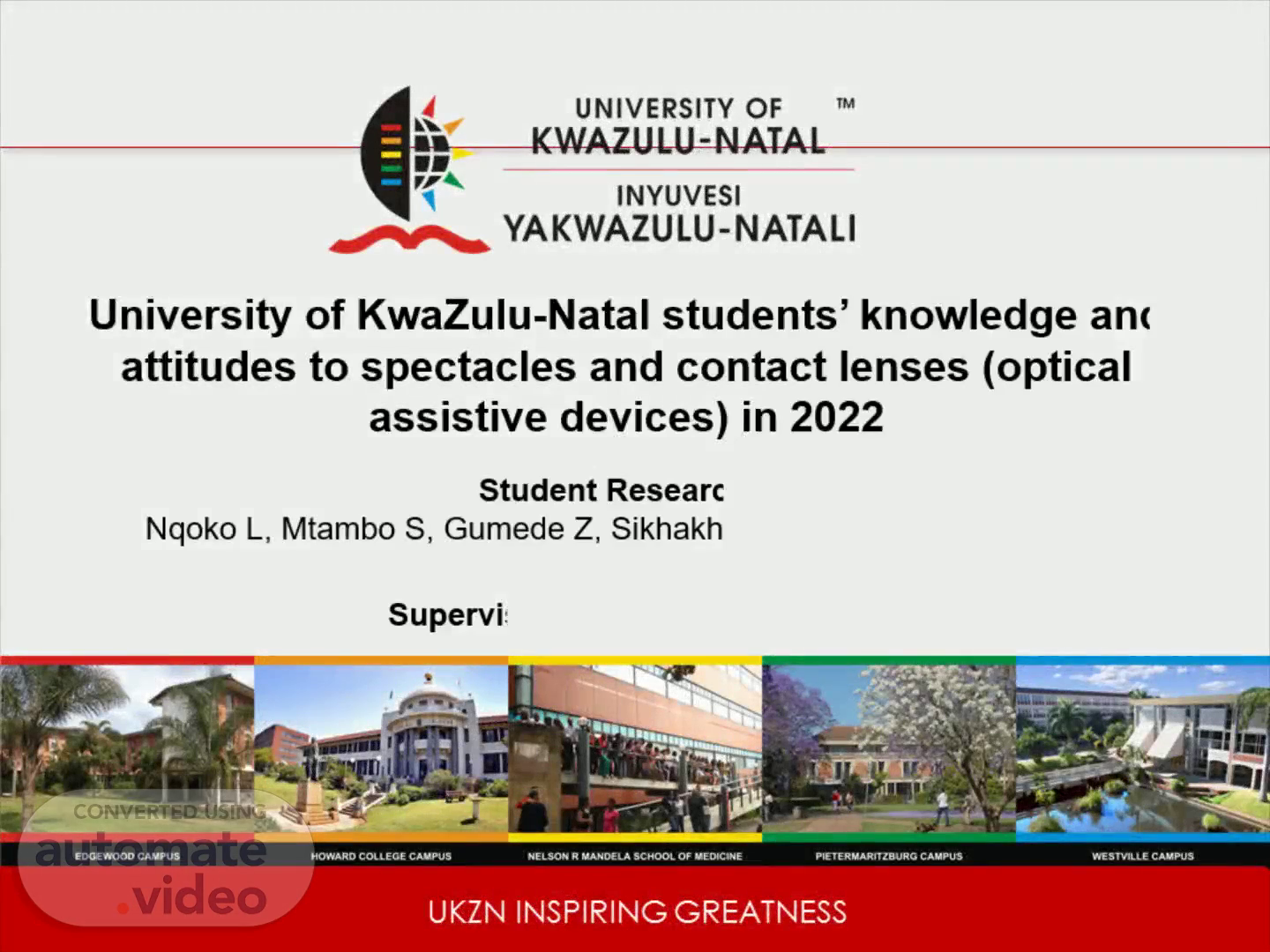
Introduction of HPCSA Guidelines and Relevant Legislation
Scene 1 (0s)
University of KwaZulu-Natal students’ knowledge and attitudes to spectacles and contact lenses (optical assistive devices) in 2022.
Scene 2 (17s)
Ignorance of refractive errors Prevalence of refractive error Affordability Lack of qualified health care providers Digital Eye Syndrome unawareness.
Scene 3 (29s)
PROBLEM STATEMENT.
Scene 4 (35s)
LITERATURE REVIEW. Author (year) Sample size Characteristics of sample study Instruments utilized Results Other comments Kobia-Acquah et al (2018) 500 Undergraduate students, 90 sampled from each of the colleges in the university and 40 were excluded. Descriptive cross sectional survey study 365 (73.0 %) had professional eye exam. 197 (39.4%) wearing spectacles. 186 needed spectacles 163 (87.6%) received and used the spectacles. The study was done at the Kwame Nkrumah University of Science and Technology (KNUST) in Kumasi, Ghana Bambamba et al (2021) 298 Undergraduate students from college of health sciences enrolled under the courses of Medicine, Dentistry, Pharmacy, Nutrition, Optometry and Nursing, 150 (50.3%) females and 148 (49.7%) males with the average age being 24 ± 5.4 years. Descriptive cross-sectional survey study 208 (69.8%) were aware of their refractive status 163 (54.7%) believed they had good eyesight. 173 (58.1%) students named ophthalmic lenses as a way of correcting refractive errors 52 (17.4%) students named medicine 29 (9.7%) named surgery 25 (8.4%) students who named contact lenses. The study was conducted at the Lúrio University in Nampula, Mpumalanga. Ocansey et al (2019) 87 Among the participants 46 were females (52.9%) and 41 males (47.1%) with an age range of 20-29, 60 (68.9%) and they had tertiary level of education Descriptive cross-sectional survey Study 44.8 % low interest in CL 27.6% is due of lack of supply 19.5% poor training The study was conducted in the capital city of Ghana, Accra, in the Greater Accra Region. Khoza et al (2020) 246 Participants were recruited from the University of KwaZulu Natal (UKZN) and also from optometric practices (10) around Durban. They were aged 18-30 years Quantitative descriptive cross-sectional study 49% were aware of CL 51.8% cleaned their CL to prevent infection 94.4 % stated cleaning CL was necessary The study was done in Durban, South Africa.
Scene 5 (1m 43s)
AIM: To investigate the knowledge and attitude of UKZN Westville Campus students towards spectacles and contact lenses..
Scene 6 (1m 57s)
Methodology. Study Design Qualitative cross-sectional descriptive study design used Data collected through a structured online questionnaire Interviews will be conducted at UKZN Westville campus.
Scene 7 (2m 8s)
Methodology. Study population UKZN Westville campus undergraduate and postgraduate students Researchers will be based at UKZN Westville campus.
Scene 8 (2m 19s)
Online questionnaire survey In person interviews Not timed (10 minutes) Designed using Google Forms.
Scene 9 (2m 29s)
Data collection procedure. Ethical Clearence Data will be collected and reviewed URL Link.
Scene 10 (2m 41s)
Data Analysis. Data will be captured with Microsoft Excel and analysed using the Statistical Package for Social Sciences (SPSS) version 25. Data will be analysed using descriptive and inferential statistics.
Scene 11 (2m 54s)
Data Quality. Data quality An already approved questionnaire will be utilised Statements written in simple language Time to complete questionnaire has been minimised Ease of completion Double data capturing Pilot study.
Scene 12 (3m 8s)
Study Limitations. Poor response rate. Dishonesty.
Scene 13 (3m 19s)
Ethical Considerations. Ethical clearance from Humanities and Social Sciences Research and Ethics Committee of the University of Kwa-Zulu-Natal. I nformed consent Private Interviews Electronic data stored in secured laptop/computer Confidentiality.
Scene 14 (3m 34s)
Significance of study. Strengthens and improves people’s attitude and knowledge. baseline for future studies . Social value.
Scene 15 (3m 45s)
Feasibility. Table 1: STUDY SCHEDULE. Mar April May June July Aug Sep Protocol write up Protocol submission for ethical clearance Data collection Data analysis Report write up and presentation.
Scene 16 (4m 3s)
Feasibility. Table 2: ANTICIPATED STUDY BUDGET. ITEM COSTS Printing R50 Photocopying R300 Poster R500 Other R300 Total R1150.
Scene 17 (4m 15s)
Research Output. Presentation of research results takes place at Discipline of Optometry on research day. Publication of results in a Google Scholar Journals. Study findings available to academic leader.
Scene 18 (4m 27s)
References. Yawn BP, Kurland M, Butterfield L, Johnson B. Barriers to seeking care following school vision in Rochester, Minnesota. J School Health. 1998;68(8):319–24. Salimath S. Sultuna S. Patil BA. Kulkarni KR. Pakistan Journal of ophthalmology. 2021. 4:37(37.4) Munsamy AJ, Chetty V, 2020. Digital eye syndrome : COVID-19 lockdown side-effect?. University of KwaZulu-Natal. Durban South Africa. Kobia -Acquah, E., Essien, E., Ablordeppey , R., Donkor, R., Ankamah-Lomotey , S. and Nartey, A., 2018. Attitudes and beliefs of undergraduate students to spectacle wear in Ghana. AOVS, 8, p.00264. Bambamba , J., Bambamba , Â., Fereira , G., Pires, P. and Cossa , Y., 2021. Knowledge, Attitudes and Practices (KAP) about Refractive Error among Students Attending Faculty of Health Sciences at Lúrio University in Mozambique, 2020. Open Journal of Ophthalmology, 12(1), pp.57-69. Ocansey , S., Ogbomo , G.O., Abu, E.K., Morny , E.K. and Adjei- Boye , O., 2019. Profile, knowledge, and attitude of contact lens users regarding contact lens wear in Ghana. Contact Lens and Anterior Eye, 42(2), pp.170-177. Khoza, N., Moodley, T., Sokhulu , S., Sotyana , N.O., Suliman, A., Hansraj, R. and van Staden , D., 2020. Knowledge, attitudes and practices of contact lens use in a South African adolescent population. African Health Sciences, 20(2), pp.768-774..